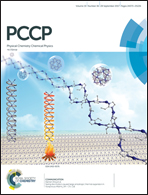Static and dynamic magnetic properties of the ferromagnetic coordination polymer [Co(NCS)2(py)2]n†
Abstract
[Co(NCS)2(py)2]n (py = pyridine) is composed of ferromagnetic chains of Co(II) cations connected by double NCS bridges. The chains are irregular because of two crystallographically inequivalent Co(II) cations. The coordination polyhedron of the Co(II) cations is a distorted octahedron built from two N and two S atoms of four equatorial NCS anions and two apical N atoms of the pyridine ligands. Magnetic and specific heat studies show that the compound undergoes a phase transition at 3.7 K to a ferromagnetic state. The determined magnetic interactions, intrachain (J/kB = 28 K) and interchain (zJ′/kB = 0.5 K), confirm the quasi 1D Ising magnetic character of [Co(NCS)2(py)2]n. Using AC magnetic susceptibility measurements the energy barriers for magnetization reversal of different relaxation processes were determined including those of the individual chains. By means of high field-high frequency ESR study the magnetic excitations were observed and explained in the frame of the Ising model in agreement with the results of the magnetic study. Ab initio calculations confirm the high magnetic anisotropy of the system and allow determination of the direction of the easy-axis. The broken symmetry DFT calculations support the ferromagnetic intrachain interactions. The energetic relations relevant for relaxations are discussed. It is concluded that the magnetic model of [Co(NCS)2(py)2]n is not a pure Ising but the transversal exchange plays a role.
![Graphical abstract: Static and dynamic magnetic properties of the ferromagnetic coordination polymer [Co(NCS)2(py)2]n](/en/Image/Get?imageInfo.ImageType=GA&imageInfo.ImageIdentifier.ManuscriptID=C7CP04189F&imageInfo.ImageIdentifier.Year=2017)


 Please wait while we load your content...
Please wait while we load your content...